PONTIAC G6 2007 Owners Manual
Manufacturer: PONTIAC, Model Year: 2007, Model line: G6, Model: PONTIAC G6 2007Pages: 486, PDF Size: 2.78 MB
Page 121 of 486

It is possible for the PASS-Key®III+ decoder
to “learn” the transponder value of a new or
replacement key. Up to 10 additional keys may
be programmed for the vehicle. The following
procedure is for programming additional keys only.
If all the currently programmed keys are lost or
do not operate, you must see your dealer or a
locksmith who can service PASS-Key
®III+ to have
keys made and programmed to the system.
See your dealer or a locksmith who can service
PASS-Key
®III+ to get a new key blank that is cut
exactly as the ignition key that operates the system.
To program the new key do the following:
1. Verify that the new key has
1stamped on it.
2. Insert the already programmed key in the
ignition and start the engine. If the engine
will not start, see your dealer for service.
3. After the engine has started, turn the key to
OFF, and remove the key.4. Insert the key to be programmed and turn it to
the ON position within �ve seconds of
removing the original key.
5. The SECURITY light will turn off once the key
has been programmed.
6. Repeat Steps 1 through 5 if additional keys
are to be programmed.
If you are ever driving and the SECURITY light
comes on and stays on, you may be able to restart
your engine if you turn it off. Your PASS-Key
®III+
system, however, is not working properly and must
be serviced by your dealer. Your vehicle is not
protected by the PASS-Key
®III+ system at
this time.
If you lose or damage your PASS-Key
®III+ key,
see your dealer or a locksmith who can service
PASS-Key
®III+ to have a new key made.
121
Page 122 of 486

Starting and Operating Your
Vehicle
New Vehicle Break-In
Notice:Your vehicle does not need an
elaborate break-in. But it will perform better in
the long run if you follow these guidelines:
Do not drive at any one constant speed, fast
or slow, for the �rst 500 miles (805 km). Do
not make full-throttle starts. Do not exceed
5,000 engine rpm. Avoid downshifting to
brake, or slow, the vehicle.
Avoid making hard stops for the �rst
200 miles (322 km) or so. During this time
your new brake linings are not yet broken
in. Hard stops with new linings can mean
premature wear and earlier replacement.
Follow this breaking-in guideline every time
you get new brake linings.
Do not tow a trailer during break-in. See
Towing a Trailer on page 296for the trailer
towing capabilities of your vehicle and more
information.Following break-in, engine speed and load can
be gradually increased.
Ignition Positions
With the key in the
ignition switch, you can
turn it to four different
positions.
Notice:Using a tool to force the key from the
ignition switch could cause damage or break
the key. Use the correct key and turn the key
only with your hand. Make sure the key is in all
the way. If none of this works, then your vehicle
needs service.
122
Page 123 of 486
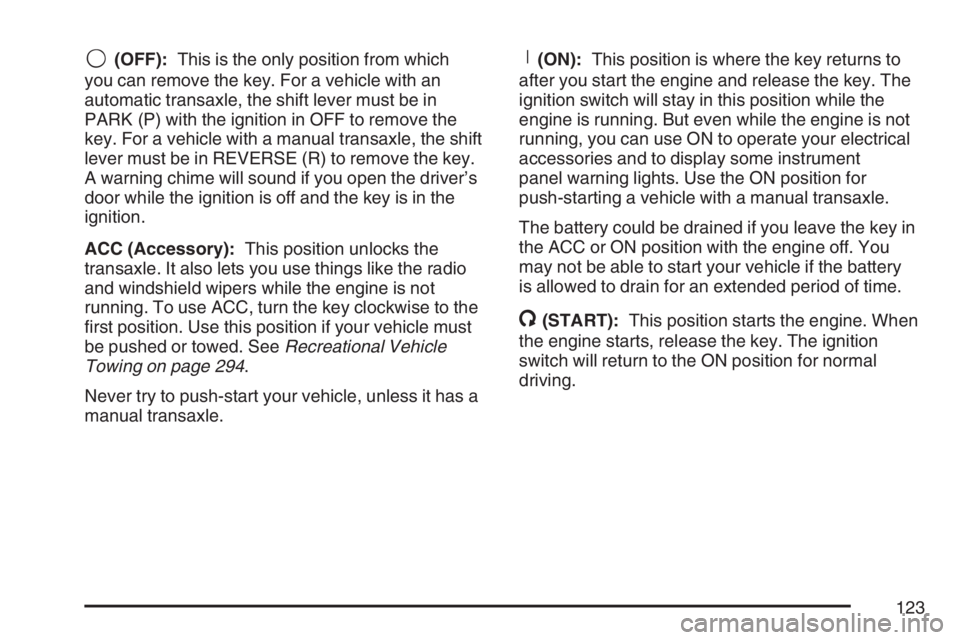
9(OFF):This is the only position from which
you can remove the key. For a vehicle with an
automatic transaxle, the shift lever must be in
PARK (P) with the ignition in OFF to remove the
key. For a vehicle with a manual transaxle, the shift
lever must be in REVERSE (R) to remove the key.
A warning chime will sound if you open the driver’s
door while the ignition is off and the key is in the
ignition.
ACC (Accessory):This position unlocks the
transaxle. It also lets you use things like the radio
and windshield wipers while the engine is not
running. To use ACC, turn the key clockwise to the
�rst position. Use this position if your vehicle must
be pushed or towed. SeeRecreational Vehicle
Towing on page 294.
Never try to push-start your vehicle, unless it has a
manual transaxle.R(ON):This position is where the key returns to
after you start the engine and release the key. The
ignition switch will stay in this position while the
engine is running. But even while the engine is not
running, you can use ON to operate your electrical
accessories and to display some instrument
panel warning lights. Use the ON position for
push-starting a vehicle with a manual transaxle.
The battery could be drained if you leave the key in
the ACC or ON position with the engine off. You
may not be able to start your vehicle if the battery
is allowed to drain for an extended period of time.
/(START):This position starts the engine. When
the engine starts, release the key. The ignition
switch will return to the ON position for normal
driving.
123
Page 124 of 486
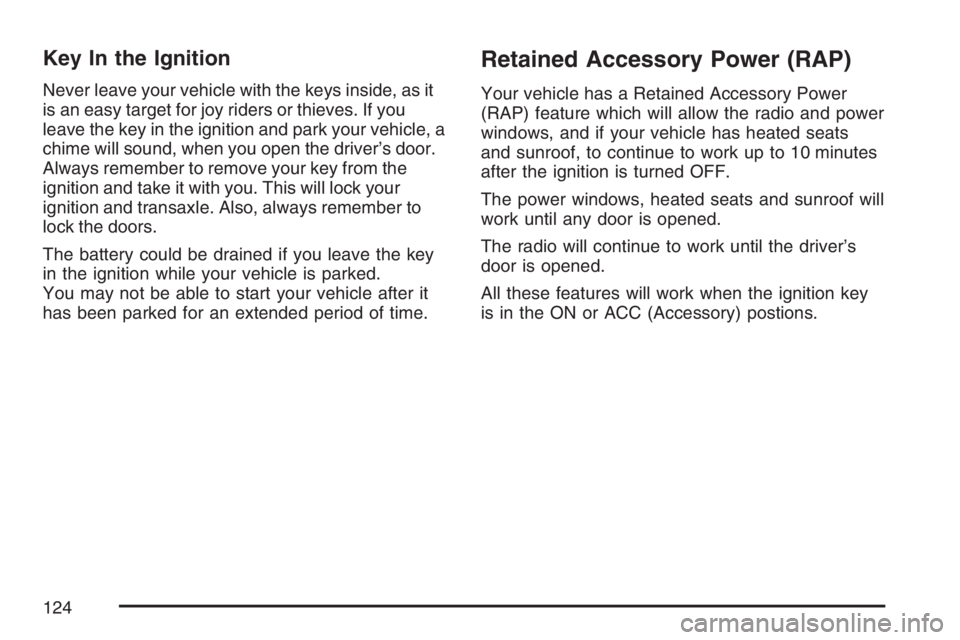
Key In the Ignition
Never leave your vehicle with the keys inside, as it
is an easy target for joy riders or thieves. If you
leave the key in the ignition and park your vehicle, a
chime will sound, when you open the driver’s door.
Always remember to remove your key from the
ignition and take it with you. This will lock your
ignition and transaxle. Also, always remember to
lock the doors.
The battery could be drained if you leave the key
in the ignition while your vehicle is parked.
You may not be able to start your vehicle after it
has been parked for an extended period of time.
Retained Accessory Power (RAP)
Your vehicle has a Retained Accessory Power
(RAP) feature which will allow the radio and power
windows, and if your vehicle has heated seats
and sunroof, to continue to work up to 10 minutes
after the ignition is turned OFF.
The power windows, heated seats and sunroof will
work until any door is opened.
The radio will continue to work until the driver’s
door is opened.
All these features will work when the ignition key
is in the ON or ACC (Accessory) postions.
124
Page 125 of 486
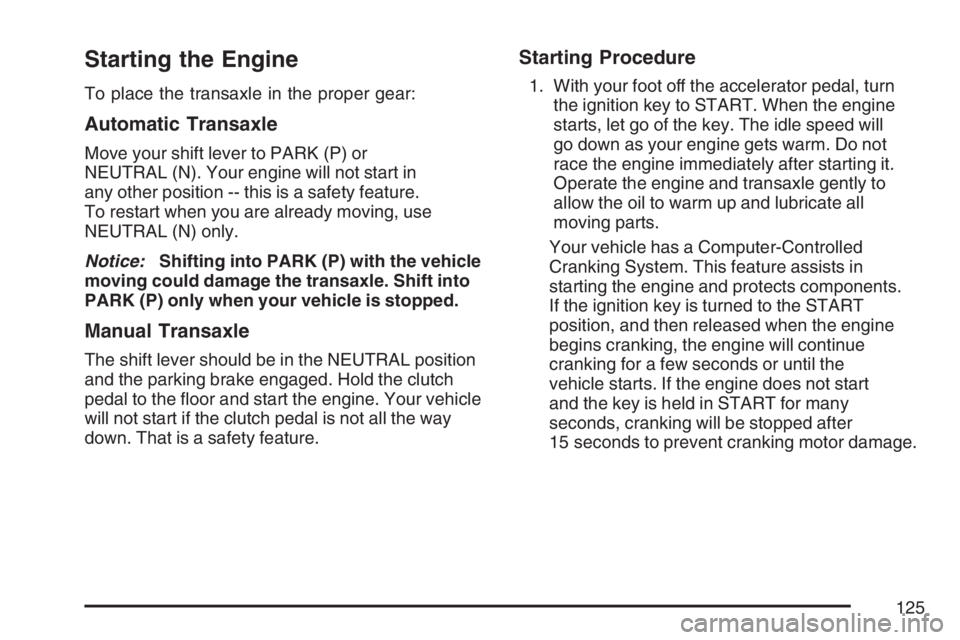
Starting the Engine
To place the transaxle in the proper gear:
Automatic Transaxle
Move your shift lever to PARK (P) or
NEUTRAL (N). Your engine will not start in
any other position -- this is a safety feature.
To restart when you are already moving, use
NEUTRAL (N) only.
Notice:Shifting into PARK (P) with the vehicle
moving could damage the transaxle. Shift into
PARK (P) only when your vehicle is stopped.
Manual Transaxle
The shift lever should be in the NEUTRAL position
and the parking brake engaged. Hold the clutch
pedal to the �oor and start the engine. Your vehicle
will not start if the clutch pedal is not all the way
down. That is a safety feature.
Starting Procedure
1. With your foot off the accelerator pedal, turn
the ignition key to START. When the engine
starts, let go of the key. The idle speed will
go down as your engine gets warm. Do not
race the engine immediately after starting it.
Operate the engine and transaxle gently to
allow the oil to warm up and lubricate all
moving parts.
Your vehicle has a Computer-Controlled
Cranking System. This feature assists in
starting the engine and protects components.
If the ignition key is turned to the START
position, and then released when the engine
begins cranking, the engine will continue
cranking for a few seconds or until the
vehicle starts. If the engine does not start
and the key is held in START for many
seconds, cranking will be stopped after
15 seconds to prevent cranking motor damage.
125
Page 126 of 486
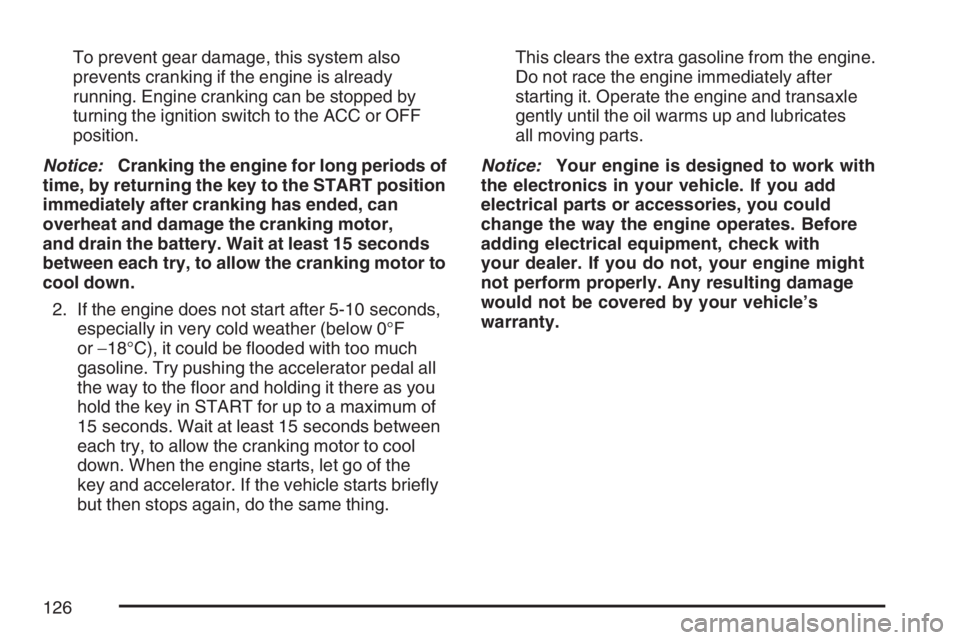
To prevent gear damage, this system also
prevents cranking if the engine is already
running. Engine cranking can be stopped by
turning the ignition switch to the ACC or OFF
position.
Notice:Cranking the engine for long periods of
time, by returning the key to the START position
immediately after cranking has ended, can
overheat and damage the cranking motor,
and drain the battery. Wait at least 15 seconds
between each try, to allow the cranking motor to
cool down.
2. If the engine does not start after 5-10 seconds,
especially in very cold weather (below 0°F
or−18°C), it could be �ooded with too much
gasoline. Try pushing the accelerator pedal all
the way to the �oor and holding it there as you
hold the key in START for up to a maximum of
15 seconds. Wait at least 15 seconds between
each try, to allow the cranking motor to cool
down. When the engine starts, let go of the
key and accelerator. If the vehicle starts brie�y
but then stops again, do the same thing.This clears the extra gasoline from the engine.
Do not race the engine immediately after
starting it. Operate the engine and transaxle
gently until the oil warms up and lubricates
all moving parts.
Notice:Your engine is designed to work with
the electronics in your vehicle. If you add
electrical parts or accessories, you could
change the way the engine operates. Before
adding electrical equipment, check with
your dealer. If you do not, your engine might
not perform properly. Any resulting damage
would not be covered by your vehicle’s
warranty.
126
Page 127 of 486
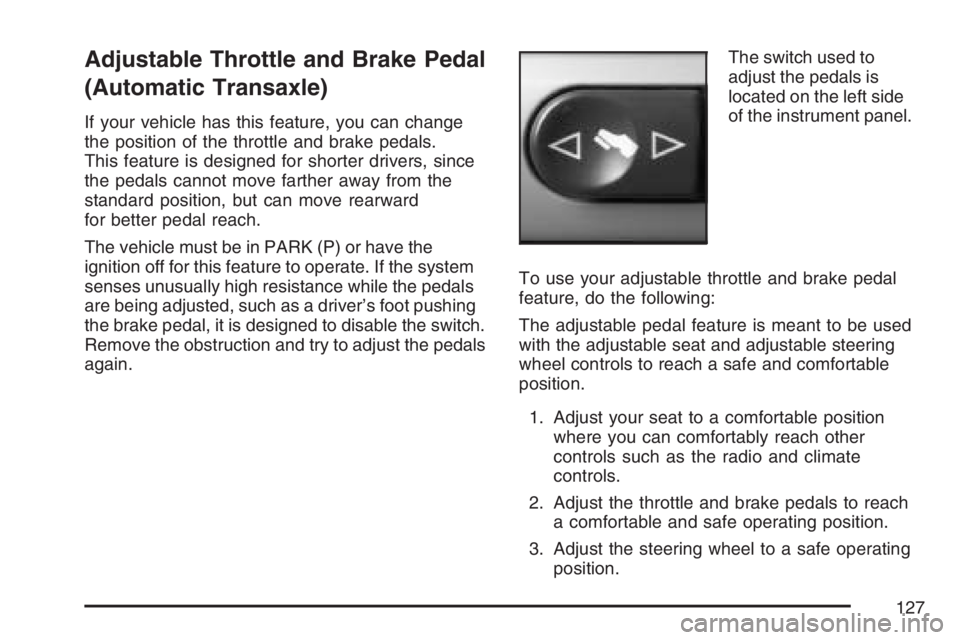
Adjustable Throttle and Brake Pedal
(Automatic Transaxle)
If your vehicle has this feature, you can change
the position of the throttle and brake pedals.
This feature is designed for shorter drivers, since
the pedals cannot move farther away from the
standard position, but can move rearward
for better pedal reach.
The vehicle must be in PARK (P) or have the
ignition off for this feature to operate. If the system
senses unusually high resistance while the pedals
are being adjusted, such as a driver’s foot pushing
the brake pedal, it is designed to disable the switch.
Remove the obstruction and try to adjust the pedals
again.The switch used to
adjust the pedals is
located on the left side
of the instrument panel.
To use your adjustable throttle and brake pedal
feature, do the following:
The adjustable pedal feature is meant to be used
with the adjustable seat and adjustable steering
wheel controls to reach a safe and comfortable
position.
1. Adjust your seat to a comfortable position
where you can comfortably reach other
controls such as the radio and climate
controls.
2. Adjust the throttle and brake pedals to reach
a comfortable and safe operating position.
3. Adjust the steering wheel to a safe operating
position.
127
Page 128 of 486

Engine Coolant Heater
Your vehicle may have this feature. In very cold
weather, 0°F (−18°C) or colder, the engine coolant
heater can provide easier starting and better fuel
economy during engine warm-up. Usually, the
coolant heater should be plugged in a minimum
of four hours prior to starting your vehicle. At
temperatures above 32°F (0°C), use of the coolant
heater is not required. Your vehicle may also have
an internal thermostat in the plug end of the cord.
This will prevent operation of the engine coolant
heater when the temperature is at or above
0°F (−18°C) as noted on the cord.
To Use the Engine Coolant Heater
1. Turn off the engine.
2. Open the hood and unwrap the electrical cord.
On the 2.4L L4 ECOTEC
®engine, the engine
coolant heater cord is located near the air
cleaner box on the passenger’s side of the
engine compartment. On the 3.5L, 3.6L and
3.9L V6 engines, the engine coolant heater
cord is located on the driver’s side around
the battery box. SeeEngine Compartment
Overview on page 318for more information
on location.3. Plug the cord into a normal, grounded
110-volt AC outlet.
{CAUTION:
Plugging the cord into an ungrounded
outlet could cause an electrical shock.
Also, the wrong kind of extension cord
could overheat and cause a �re. You
could be seriously injured. Plug the cord
into a properly grounded three-prong
110-volt AC outlet. If the cord will not
reach, use a heavy-duty three-prong
extension cord rated for at least 15 amps.
4. Before starting the engine, be sure to unplug
and store the cord as it was before to keep it
away from moving engine parts. If you do
not, it could be damaged.
How long should you keep the coolant
heater plugged in? The answer depends
on the outside temperature, the kind
of oil you have, and some other things.
128
Page 129 of 486
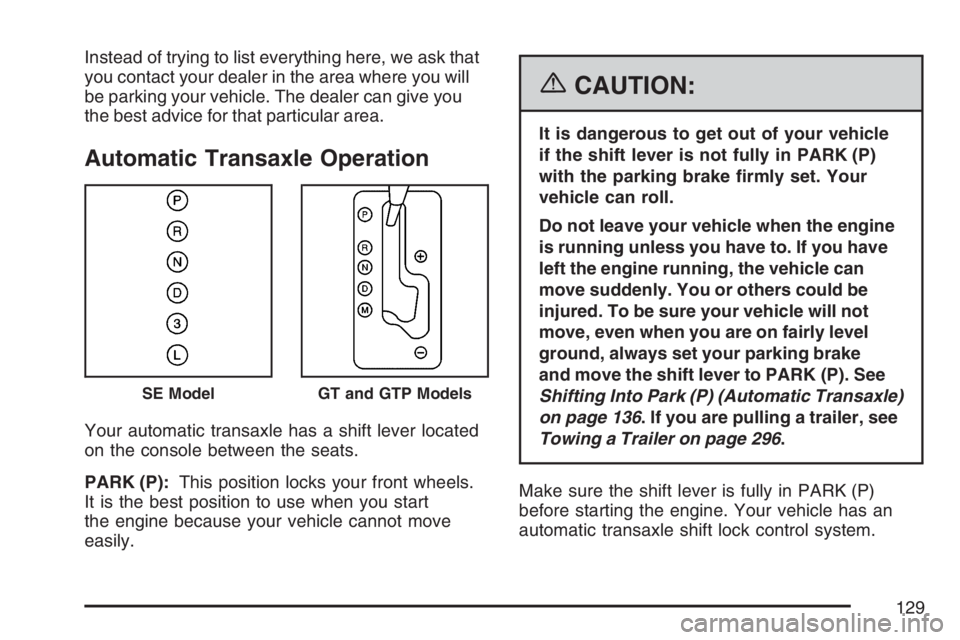
Instead of trying to list everything here, we ask that
you contact your dealer in the area where you will
be parking your vehicle. The dealer can give you
the best advice for that particular area.
Automatic Transaxle Operation
Your automatic transaxle has a shift lever located
on the console between the seats.
PARK (P):This position locks your front wheels.
It is the best position to use when you start
the engine because your vehicle cannot move
easily.
{CAUTION:
It is dangerous to get out of your vehicle
if the shift lever is not fully in PARK (P)
with the parking brake �rmly set. Your
vehicle can roll.
Do not leave your vehicle when the engine
is running unless you have to. If you have
left the engine running, the vehicle can
move suddenly. You or others could be
injured. To be sure your vehicle will not
move, even when you are on fairly level
ground, always set your parking brake
and move the shift lever to PARK (P). See
Shifting Into Park (P) (Automatic Transaxle)
on page 136. If you are pulling a trailer, see
Towing a Trailer on page 296.
Make sure the shift lever is fully in PARK (P)
before starting the engine. Your vehicle has an
automatic transaxle shift lock control system.
SE ModelGT and GTP Models
129
Page 130 of 486

You have to apply your regular brake �rst and then
press the shift lever button before you can shift from
PARK (P) while the ignition key is in ON. If you
cannot shift out of PARK (P), ease pressure on the
shift lever and push the shift lever all the way into
PARK (P) as you maintain brake application. Press
the shift lever button and then move the shift lever
into another gear. SeeShifting Out of Park (P)
(Automatic Transaxle) on page 138later in this
section.
REVERSE (R):Use this gear to back up.
Notice:Shifting to REVERSE (R) while your
vehicle is moving forward could damage the
transaxle. The repairs would not be covered by
your warranty. Shift to REVERSE (R) only after
your vehicle is stopped.
To rock your vehicle back and forth to get out of
snow, ice, or sand without damaging your
transaxle, seeIf Your Vehicle is Stuck in Sand,
Mud, Ice, or Snow on page 287.NEUTRAL (N):In this position, your engine does
not connect with the wheels. To restart when
you are already moving, use NEUTRAL (N) only.
Also, use NEUTRAL (N) when your vehicle is
being towed.
{CAUTION:
Shifting into a drive gear while your
engine is running at high speed is
dangerous. Unless your foot is �rmly on
the brake pedal, your vehicle could move
very rapidly. You could lose control and
hit people or objects. Do not shift into a
drive gear while your engine is running at
high speed.
Notice:Shifting out of PARK (P) or
NEUTRAL (N) while the engine is running at
high speed may damage the transaxle. The
repairs would not be covered by your warranty.
Be sure the engine is not running at high
speeds when shifting your vehicle.
130